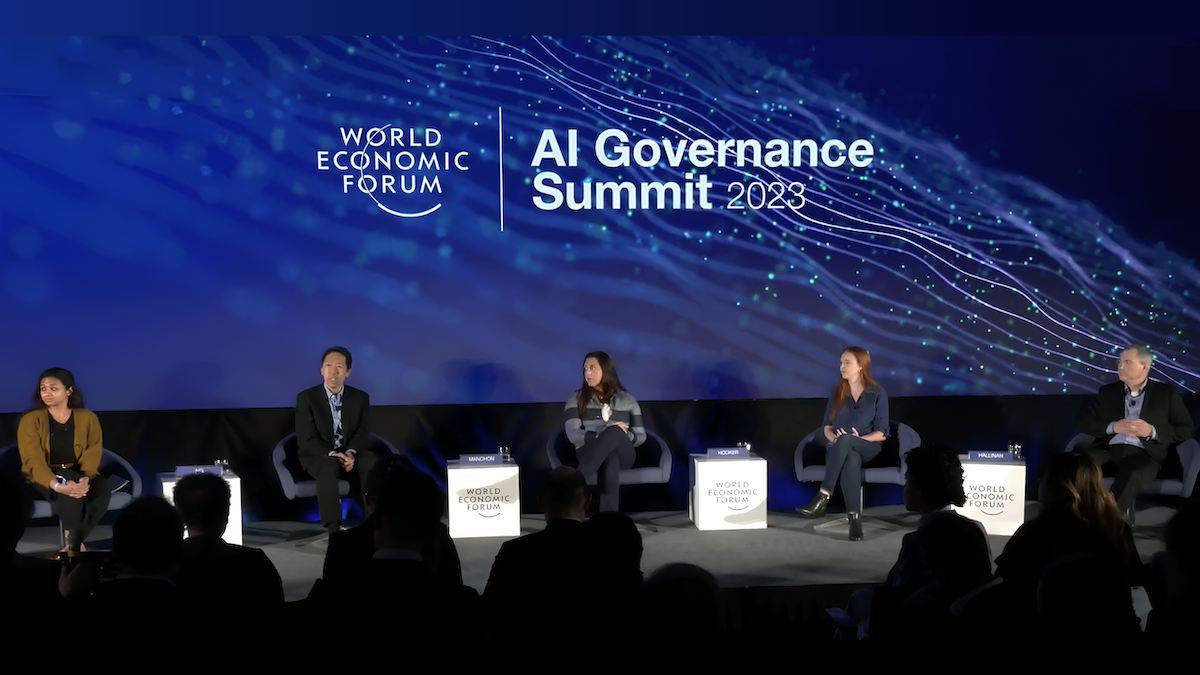Dear friends,
This week, I’m speaking at the World Economic Forum (WEF) and Asia-Pacific Economic Cooperation (APEC) meetings in San Francisco, where leaders in business and government have convened to discuss AI and other topics. My message at both events is simple: Governments should not outlaw open source software or pass regulations that stifle open source development.
When I speak with senior U.S. government officials, I sense that few think the possibility that AI will lead to human extinction is a realistic risk. This topic tends to lead to eye-rolls. But they genuinely worry about AI risks such as disinformation. In comparison, the EU is more concerned — unnecessarily, in my view — about the risk of extinction, while also worried about other, more concrete harms.
Many nations and corporations are coming to realize they will be left behind if regulation stifles open source. After all, the U.S. has a significant concentration of generative AI talent and technology. If we raise the barriers to open source and slow down the dissemination of AI software, it will only become harder for other nations to catch up. Thus, while some might argue that the U.S. should slow down dissemination of AI (an argument that I disagree with), that certainly would not be in the interest of most nations.
Keep learning! Andrew
P.S. Many teams that build applications based on large language models (LLMs) worry about their safety and security, and such worries are a significant barrier to shipping products. For example, might the application leak sensitive data, or be tricked into generating inappropriate outputs? Our new short course shows how you can mitigate hallucinations, data leakage, and jailbreaks. Learn more in “Quality and Safety for LLM Applications,” taught by Bernease Herman and created in collaboration with WhyLabs (disclosure: an AI Fund portfolio company). Available now!
News
Actors Reach Accord on AIThe longest actors’ strike in Hollywood history ended as actors and studios reached an accord on the use of generative AI in making movies. What’s new: Film studios must seek an actor’s consent before using a generated likeness or performance and compensate the actor, according to an agreement between the trade union Screen Actors Guild-American Federation of Television and Radio Artists (SAG-AFTRA) and the Alliance of Motion Picture and Television Producers (TMPTP). The pact will remain in effect for three years, once it has been ratified by SAG-AFTRA members. How it works: The agreement covers digital replicas of human actors, synthetic performers, and simulated performances created using AI and other technologies that may not be generally recognized as AI. The parties argued over terms with respect to AI until the very last day of their 118-day negotiation, according to SAG-AFTRA’s president. Among the provisions:
Behind the news: The agreement followed a similar three-year deal in September that ended the concurrent strike by Writers Guild of America. Yes, but: The agreement covers on-screen actors. It does not cover voice or motion actors in video games or television animation. In September, SAG-AFTRA authorized a strike against a group of video game companies if negotiations, which are ongoing, stall. Negotiations over television animation are expected as well. Why it matters: The actors’ agreement could set an international example for limits on AI in the performing arts, thanks to the U.S. film and television industry’s global reach. Entertainers’ unions in Europe and Canada are contemplating strikes inspired by SAG-AFTRA’s, and they may seek similar agreements. We’re thinking: As with the screenwriters’ contract, the agreement between actors and studios gives everyone three years to experiment with AI while respecting the consent, credit, and compensation of creative workers. We hope that shows made in this period provide ample evidence that such tools can yield wonderful productions that enlarge the market, and that the next agreement focuses more on growing the use of AI and dividing the winnings fairly among actors, studios, and technologists.
Cyberattack Strikes OpenAIChatGPT suffered a cyberattack apparently tied to the Kremlin. What's new: A ChatGPT outage on November 8 most likely was caused by a distributed denial of service (DDoS) attack, OpenAI revealed. What happened: ChatGPT went down shortly before 9:00 a.m. Eastern Time and remained out of service for about 90 minutes. Intermittent outages of unknown cause had affected OpenAI and other services during the previous two days.
DDoS basics: In a DDoS attack, malicious programs running independently on numerous machines flood a website with requests, disrupting service. The distributed nature of the attack makes it difficult to trace or combat. Almost all cloud providers and large websites use DDoS mitigation services or their own technology to defend against such attacks. However, such defenses don’t always block an especially determined or resourceful attacker. Why it matters: The ChatGPT outage is a sobering reminder that API-powered services are vulnerable to targeted attacks, and providers need to be proactive about protecting themselves and their users. We're thinking: While no one likes downtime, it’s hard to defend against a state-sponsored DDoS. It’s a testament to OpenAI’s impact that just 90 minutes of downtime was felt around the world.
A MESSAGE FROM DEEPLEARNING.AINew short course! “Quality and Safety for LLM Applications” will help you enhance the safety of large language model applications by detecting issues like data leakage, hallucination, toxicity, and jailbreaks. Start making your apps more secure today. Enroll now
Anthropic Cultivates AlternativesWeeks after it announced a huge partnership deal with Amazon, Anthropic doubled down on its earlier relationship with Alphabet. What's new: Anthropic, which provides large language models, agreed to use Google’s cloud-computing infrastructure in return for a $2 billion investment, The Wall Street Journal reported. The deal follows an earlier multibillion-dollar partnership that saw Anthropic commit to training new models on Amazon Web Services. How it works: Google invested $500 million up front and will add $1.5 billion more over an unspecified time period. The new funding builds on $300 million that Google gave to Anthropic earlier in the year for a 10 percent stake in the company. Google’s current stake in Anthropic is undisclosed.
Behind the news: Anthropic rose rapidly from AI startup to coveted foundation-model partner.
Why it matters: The Anthropic-Google deal changes the shape of the startup’s relationships with large cloud providers. Anthropic's deal with Amazon dwarfed Google’s initial investment and seemed like a formative partnership akin to OpenAI’s lucrative Microsoft pair-up. Now, Anthropic is more like a vertex in a triangle, bound by close relationships with competing partners. We're thinking: Anthropic hasn’t raised as much total funding as OpenAI ($12.7 billion and counting), but its relationships with both Google and Amazon give it more flexibility to choose different infrastructure for different tasks. The benefits presumably will flow not only to the three companies but also to independent developers, who can choose among stellar proprietary foundational models — not to mention open source alternatives — from three major cloud providers.
AI Builds Better Sorting AlgorithmsOnline sorting algorithms run trillions of times a day to organize lists according to users’ interests. New work found faster alternatives. What’s new: Daniel J. Mankowitz and colleagues at Google developed AlphaDev, a system that learned to generate algorithms that sort three to five numbers faster than previous state-of-the-art methods. Accelerating such algorithms can expedite the sorting of lists of any size — say, for search engines, ecommerce sites, and the like — since algorithms that sort more elements often call algorithms that sort fewer elements. Key insight: Most programmers implement sorting algorithms in a high-level programming language like C++, which a compiler translates into Assembly Language instructions that control the processor and memory. A compiler can translate a single line of C++ into a variety of sequences of Assembly instructions that are equivalent functionally but vary in their speed (number of Assembly instructions required). A reinforcement learning agent can learn to choose a translation that maximizes speed. How it works: AlphaDev is a collection of neural networks that learn jointly via reinforcement learning. The authors initialized the system by giving it a sequence of unsorted numbers and an empty list of Assembly instructions. It built algorithms by adding Assembly instructions one by one. It earned rewards for choosing instructions that sorted the numbers correctly and quickly.
Results: The authors tested two approaches to rewarding speed, minimizing either Assembly instructions or average runtime over a number of inputs. When AlphaDev minimized the number of Assembly instructions, it found an algorithm that sorted three integers using 17 instructions instead of the previous state-of-the-art algorithm, a human-engineered one that used 18 instructions. Its algorithm for sorting four integers used 28 instructions, equal to the typical one. Its algorithm for sorting five integers had 42 instructions, compared to the alternative’s 46 instructions. When AlphaDev optimized for runtime (running on Intel 6th-generation Core “Skylake” processor), sorting three integers took 2.18 nanoseconds, compared to the typical algorithm’s 4.86 nanoseconds. Sorting four unsigned integers took 1.96 nanoseconds instead of 5.43 nanoseconds and sorting five of them took 1.98 nanoseconds instead of 6.79 nanoseconds. AlphaDev achieved smaller speedups with longer number sequences: Sorting 16 unsigned integers took 9.5 nanoseconds instead of 10.5 nanoseconds, and sorting 262,144 numbers took 60.8 nanoseconds instead of 61.4 nanoseconds. Why it matters: This work repurposes the training method and architecture of game-playing models like AlphaZero to solve real-world problems. The trick is to reframe the task of writing a sorting algorithm as a reinforcement learning problem. We’re thinking: What other algorithms can this approach optimize? How much faster will they be? Let’s get these questions sorted!
A MESSAGE FROM DEEPLEARNING.AIExperience the fastest-growing course on Coursera this year, Generative AI for Everyone! Led by Andrew Ng, delve into generative AI and its applications in both professional and personal settings. Enroll now
Subscribe and view previous issues here.
Thoughts, suggestions, feedback? Please send to thebatch@deeplearning.ai. Avoid our newsletter ending up in your spam folder by adding our email address to your contacts list.
|
.png?upscale=true&width=1200&upscale=true&name=January%2025%2c%202023%20(32).png)



.png?upscale=true&width=1200&upscale=true&name=The%20Batch%20ads%20and%20exclusive%20banners%20(80).png)


.png?upscale=true&width=1200&upscale=true&name=The%20Batch%20ads%20and%20exclusive%20banners%20(72).png)